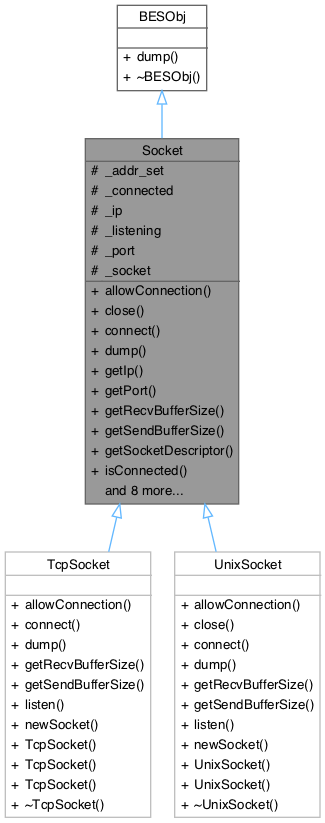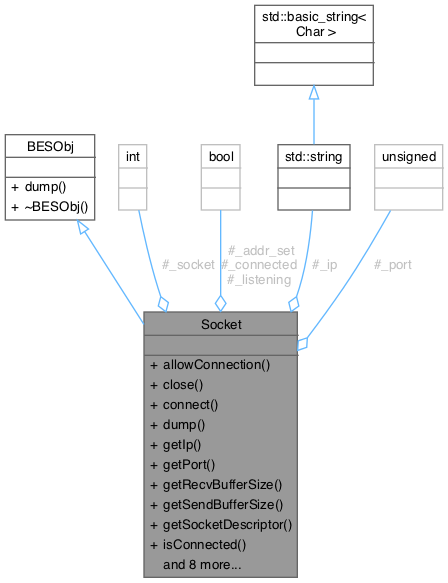Socket Class Referenceabstract
Inheritance diagram for Socket:

Collaboration diagram for Socket:

Public Member Functions | |
| virtual bool | allowConnection ()=0 |
| virtual void | close () |
| virtual void | connect ()=0 |
| virtual void | dump (std::ostream &strm) const |
| dump the contents of this object to the specified ostream | |
| std::string | getIp () |
| unsigned int | getPort () |
| virtual unsigned int | getRecvBufferSize ()=0 |
| virtual unsigned int | getSendBufferSize ()=0 |
| virtual int | getSocketDescriptor () |
| virtual bool | isConnected () |
| virtual bool | isListening () |
| virtual void | listen ()=0 |
| virtual Socket * | newSocket (int socket, struct sockaddr *addr)=0 |
| virtual int | receive (char *inBuff, const int inSize) |
| virtual void | send (const std::string &str, int start, int end) |
| Socket (int socket, struct sockaddr *addr) | |
Protected Attributes | |
| bool | _addr_set |
| bool | _connected |
| std::string | _ip |
| bool | _listening |
| unsigned int | _port |
| int | _socket |
Detailed Description
Constructor & Destructor Documentation
◆ Socket()
◆ ~Socket()
Member Function Documentation
◆ dump()
|
virtual |
dump the contents of this object to the specified ostream
This method is implemented by all derived classes to dump their contents, in other words, any state they might have, private variables, etc...
The inline function below can be used to dump the contents of an OPeNDAPObj object. For example, the object Animal is derived from BESObj. A user could do the following:
Animal *a = new dog( "Sparky" ) ; cout << a << endl ;
And the dump method for dog could display the name passed into the constructor, the (this) pointer of the object, etc...
- Parameters
-
strm C++ i/o stream to dump the object to
Implements BESObj.
Reimplemented in TcpSocket, and UnixSocket.
◆ getIp()
◆ getPort()
◆ getSocketDescriptor()
◆ isConnected()
◆ isListening()
Member Data Documentation
◆ _addr_set
◆ _connected
◆ _ip
◆ _listening
◆ _port
◆ _socket
The documentation for this class was generated from the following file: